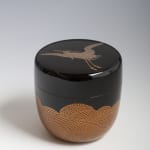Yoshida Jun’ichirō
Tea Caddy with Egret over Waves, 1930s
Maki-e silver and gold lacquer on wood
Size 2¾ x 2¾ x 2¾ in. (7.3 x 7.3 x 7.3 cm)
T-4218-1
Further images
-
(View a larger image of thumbnail 1
)

-
(View a larger image of thumbnail 2
)

-
(View a larger image of thumbnail 3
)

-
(View a larger image of thumbnail 4
)

-
(View a larger image of thumbnail 5
)

-
(View a larger image of thumbnail 6
)

-
(View a larger image of thumbnail 7
)

-
(View a larger image of thumbnail 8
)

-
(View a larger image of thumbnail 9
)

-
(View a larger image of thumbnail 10
)

-
(View a larger image of thumbnail 11
)

Natsume (tea caddy), the turned-wood body decorated in gold and silver hiramaki-e and takamaki-e against a polished black-lacquer ground with an egret in flight on the lid and stylized waves...
Natsume (tea caddy), the turned-wood body decorated in gold and silver hiramaki-e and takamaki-e against a polished black-lacquer ground with an egret in flight on the lid and stylized waves around the lower part of the sides, the interior and base polished black lacquer, the rims gold lacquer
Signed in red lacquer on the base Jun’ichirō saku 醇一郎作 (Made by Jun’ichirō)
Fitted wooden tomobako box inscribed Sagi mon さぎ文 (Egret design) and signed inside the lid Jun’ichirō saku 醇一郎作 (Made by Jun’ichirō) with a seal
The distinguished lacquerer Yoshida Jun’ichirō was born in Niigata Prefecture and moved to Tokyo in 1912 at the tender age of 14, working by day but also finding time to study painting in Nihonga (neo-nativist) style. He was eventually apprenticed to the great lacquerer Uematsu Hōbi (1872–1933) and first exhibited his work in 1924, thereafter showing regularly at the Bunten national exhibition and its successors.
Signed in red lacquer on the base Jun’ichirō saku 醇一郎作 (Made by Jun’ichirō)
Fitted wooden tomobako box inscribed Sagi mon さぎ文 (Egret design) and signed inside the lid Jun’ichirō saku 醇一郎作 (Made by Jun’ichirō) with a seal
The distinguished lacquerer Yoshida Jun’ichirō was born in Niigata Prefecture and moved to Tokyo in 1912 at the tender age of 14, working by day but also finding time to study painting in Nihonga (neo-nativist) style. He was eventually apprenticed to the great lacquerer Uematsu Hōbi (1872–1933) and first exhibited his work in 1924, thereafter showing regularly at the Bunten national exhibition and its successors.










